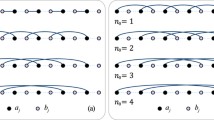Abstract
The signed loop approach is a beautiful way to rigorously study the two-dimensional Ising model with no external field. In this paper, we explore the foundations of the method, including details that have so far been neglected or overlooked in the literature. We demonstrate how the method can be applied to the Ising model on the square lattice to derive explicit formal expressions for the free energy density and two-point functions in terms of sums over loops, valid all the way up to the self-dual point. As a corollary, it follows that the self-dual point is critical both for the behaviour of the free energy density, and for the decay of the two-point functions.







Similar content being viewed by others
Notes
A picture of the same configurations appears in [7] to point out the error in Vdovichenko’s paper; it is crucial here to take the multiplicities of the loops into account.
References
Aizenman, M., Barsky, D.J., Fernández, R.: The phase transition in a general class of Ising-type models is sharp. J. Stat. Phys. 47(3–4), 343–374 (1987). MR894398 (89f:82013)
Beffara, V., Duminil-Copin, H.: Smirnov’s fermionic observable away from criticality 40 (2012). arXiv:1010.0526 [math.PR]
Burgoyne, P.N.: Remarks on the combinatorial approach to the Ising problem. J. Math. Phys. 4, 1320–1326 (1963). MR0155631 (27 #5565)
Cimasoni, D.: A generalized Kac-Ward formula. J. Stat. Mech. Theory E (2010JUL), P07023 (2010). arXiv:1004.3158
da Costa, G.A.T.F., Maciel, A.L.: Combinatorial formulation of Ising model revisited. Rev. Bras. Ensino Fis. 25(1), 49–59 (2003). arXiv:math-ph/0304033
Dobrushin, R.L.: Existence of a phase transition in two-dimensional and three-dimensional Ising models. Teor. Veroâtn. Ee Primen. 10(2), 209–230 (1965). Translated as Theor. Probab. Appl. X(2), 193–213 (1965)
Dolbilin, N.P., Shtan’ko, M.A., Shtogrin, M.I.: Combinatorial problems in the two-dimensional Ising model. Tr. Mat. Inst. Steklova 196, 51–65 (1991). Translated in Proc. Steklov Inst. Math. 1992 (4), 57–72. Discrete geometry and topology (Russian). MR1111292 (92i:05083)
Dolbilin, N.P., Zinov’ev, Yu.M., Mishchenko, A.S., Shtan’ko, M.A., Shtogrin, M.I.: The two-dimensional Ising model and the Kac-Ward determinant. Izv. Ross. Akad. Nauk Ser. Mat. 63(4), 79–100 (1999). MR1717680 (2000j:82008)
Fisher, M.E.: Critical temperatures of anisotropic Ising lattices. II. General upper bounds. Phys. Rev. 162(2), 480–485 (1967)
Glasser, M.L.: Exact partition function for the two-dimensional Ising model. Am. J. Phys. 38(8), 1033–1036 (1970)
Griffiths, R.B.: Peierls proof of spontaneous magnetization in a two-dimensional Ising ferromagnet. Phys. Rev. 136, A437–A439 (1964). MR0189681 (32 #7103)
Griffiths, R.B.: Correlations in Ising ferromagnets. III. A mean-field bound for binary correlations. Commun. Math. Phys. 6(2), 121–127 (1967). MR1552524
Helmuth, T.: Planar Ising model observables and non-backtracking walks (2012). arXiv:1209.3996
Ising, E.: Beitrag zur Theorie des Ferromagnetismus. Z. Phys. 31(1925FEB–APR), 253–258 (1925)
Kac, M., Ward, J.C.: A combinatorial solution of the two-dimensional Ising model. Phys. Rev. 88(6), 1332–1337 (1952)
Kadanoff, L.P., Ceva, H.: Determination of an operator algebra for the two-dimensional Ising model. Phys. Rev. B 3(3), 3918–3939 (1971). MR0389111 (52 #9942)
Kaufman, B.: Crystal statistics. II. Partition function evaluated by spinor analysis. Phys. Rev. 76(8), 1232–1243 (1949)
Kaufman, B., Onsager, L.: Crystal statistics. III. Short-range order in a binary Ising lattice. Phys. Rev. 76(8), 1244–1252 (1949)
Landau, L.D., Lifshitz, E.M.: Statistical Physics, Part 1. Course of Theoretical Physics, vol. 5. Butterworth–Heinemann, Oxford (1980). Translated from the Russian by J.B. Sykes and M.J. Kearsley, 3rd edn., revised and enlarged
McCoy, B.M., Wu, T.T.: The Two-Dimensional Ising Model. Harvard University Press, Cambridge (1973)
Onsager, L.: Crystal statistics. I. A two-dimensional model with an order-disorder transition. Phys. Rev. 65, 117–149 (1944). MR0010315 (5,280d)
Palmer, J.: Planar Ising Correlations. Progress in Mathematical Physics, vol. 49. Birkhäuser, Boston (2007). MR2332010 (2008h:82001)
Peierls, R.: On Ising’s model of ferromagnetism. Proc. Camb. Philos. Soc. 32, 477–481 (1936)
Sherman, S.: Combinatorial aspects of the Ising model for ferromagnetism. I. A conjecture of Feynman on paths and graphs. J. Math. Phys. 1, 202–217 (1960). MR0119512 (22 #10273)
Sherman, S.: Addendum: combinatorial aspects of the Ising model for ferromagnetism. I. A conjecture of Feynman on paths and graphs. J. Math. Phys. 4, 1213–1214 (1963). MR0156639 (27 #6560)
Simon, B.: The Statistical Mechanics of Lattice Gases, vol. I. Princeton Series in Physics. Princeton University Press, Princeton (1993). MR1239893 (95a:82001)
Smirnov, S.: Conformal invariance in random cluster models. I. Holomorphic fermions in the Ising model. Ann. Math. 172(2), 1435–1467 (2010). MR2680496 (2011m:60302)
Vdovichenko, N.V.: A calculation of the partition function for a plane dipole lattice. Sov. Phys. JETP 20, 477–488 (1965). MR0181393 (31 #5622)
Whitney, H.: On regular closed curves in the plane. Compos. Math. 4, 276–284 (1937). MR1556973
Author information
Authors and Affiliations
Corresponding author
Additional information
The second author was financially supported by Vidi grant 639.032.916 of the Netherlands Organisation for Scientific Research (NWO).
Rights and permissions
About this article
Cite this article
Kager, W., Lis, M. & Meester, R. The Signed Loop Approach to the Ising Model: Foundations and Critical Point. J Stat Phys 152, 353–387 (2013). https://doi.org/10.1007/s10955-013-0767-z
Received:
Accepted:
Published:
Issue Date:
DOI: https://doi.org/10.1007/s10955-013-0767-z



